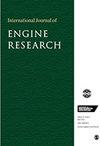Tribological investigation of the new combustion chamber with wall-guided fuel injection in a diesel engine
IF 2.1
4区 工程技术
Q2 ENGINEERING, MECHANICAL
引用次数: 0
Abstract
Reducing pollutants and increasing thermal efficiency in internal combustion engines is possible by creating better air-fuel mixtures and optimizing the combustion process. In this context, a new combustion chamber providing directed fuel injection was used in a single cylinder diesel engine with a standard combustion chamber. Thus, it was aimed to investigate the tribological behavior of engines with different combustion chambers on long-term engine operation. In engine experiments using two different combustion chambers, the engine was operated at 100 h and partial load. The results of the study showed that changes in combustion chamber structure closely modify engine tribology under the same engine and operating conditions (compression ratio, spray angle and amount, speed, etc.). Looking at the cylinder surfaces examined under an optical microscope, the new combustion chamber showed abrasive wear lines with lower intensity than the standard combustion chamber, while SEM/EDX analysis of the piston ring surfaces showed a similar result. Especially when the analysis of the second ring used in the standard combustion chamber is examined, abrasion occurred in a wider area. Abrasive wear lines were found to be longer, especially in the first ring of the new combustion chamber. It is considered that combustion parameters and exhaust formation processes bring about load/temperature variations of engine lubricating oil and engine components in a chain reaction. This has been found to change the wear levels in engine components and could directly contribute to engine life.柴油机壁导燃油喷射新型燃烧室的摩擦学研究
通过创造更好的空气-燃料混合物和优化燃烧过程,可以减少内燃机中的污染物并提高热效率。在这种情况下,在带有标准燃烧室的单缸柴油发动机中使用了可提供定向燃料喷射的新型燃烧室。因此,目的是研究采用不同燃烧室的发动机在长期运行时的摩擦学行为。在使用两种不同燃烧室的发动机实验中,发动机在部分负荷下工作了 100 小时。研究结果表明,在相同的发动机和工作条件(压缩比、喷射角度和数量、转速等)下,燃烧室结构的变化会密切改变发动机的摩擦学。在光学显微镜下观察气缸表面,新型燃烧室比标准燃烧室显示出强度更低的磨损线,而活塞环表面的 SEM/EDX 分析也显示出类似的结果。特别是在对标准燃烧室中使用的第二个活塞环进行分析时,磨损的范围更大。磨损线更长,尤其是在新燃烧室的第一道环上。我们认为,燃烧参数和废气形成过程会导致发动机润滑油和发动机部件的负荷/温度发生连锁反应变化。研究发现,这将改变发动机部件的磨损程度,并可能直接影响发动机的使用寿命。
本文章由计算机程序翻译,如有差异,请以英文原文为准。
求助全文
约1分钟内获得全文
求助全文
来源期刊

International Journal of Engine Research
工程技术-工程:机械
CiteScore
6.50
自引率
16.00%
发文量
130
审稿时长
>12 weeks
期刊介绍:
The International Journal of Engine Research publishes high quality papers on experimental and analytical studies of engine technology.
 求助内容:
求助内容: 应助结果提醒方式:
应助结果提醒方式:


